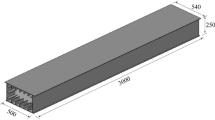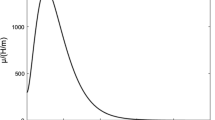Abstract
Aimed at the corrosion problem of the commonly used steel strand in the structure engineering, the Metal Magnetic Memory (MMM) was adopted as the non-destructive detection method in this paper. Firstly, based on the magnetic dipole model, the theoretical equations of the Self-Magnetic Flux Leakage (SMFL) for the trapezoidal corrosion section were derived, and the trend of the SMFL was depicted by the software of MATLAB. Then, the experiment of the corrosion detection for the unstressed steel strand based on the MMM was carried out. Ultimately, combined with the above theoretical model, the experimental data were analyzed. The results show that the corrosion of steel material can be relatively precisely calculated by the Faraday's first law of electrolysis. Via the horizontal scanning, the length of the corrosion region can be effectively obtained by the intersections of the x-Bx curves, and the theoretical model is verified. And via the vertical scanning, the inverse point x-z curve presents an inverted U-shape for the corroded steel strand and becomes a new means to determine the range of the corrosion areas. The findings have extensive prospects for the non-destructive detection in civil engineering.
Similar content being viewed by others
References
Baumvol, I. J. R. (2010). “Radiation-enhanced diffusion as a coating method for protection against corrosion and wear.” Physica Status Solidi, vol. 67, no. 1, pp. 287–298. DOI: 10.1002/pssa.2210670128.
Benabou, A., Clénet, S., and Piriou, F. (2003). “Comparison of preisach and Jiles-Atherton models to take into account hysteresis phenomenon for finite element analysis.” Journal of Magnetism & Magnetic Materials, vol. 261, no. 1, pp. 39–160. DOI: 10.1016/S0304-8853(02)01463-4.
Beskhyroun, S., Oshima, T., Mikami, S., and Yamazaki, T. (2003). “Steel structural damage detection and localization using vibration-based damage identification methods.” The Japan Society of Mechanical Engineers, Tokyo, Japan, vol. 2003, pp. 395–400.
Cunha, A., Sarmento, A. M., Lage, A., and Caetano, E. (2012). “Stress measurement and material defect detection in steel strands by magneto elastic effect. Comparison with other non-destructive measurement technique.” Bridge Maintenance Safety Management Resilience & Sustainability, vol. 81, no. 1, pp. 914–921. DOI: 10.1201/b12352-126.
Farhidzadeh, A. and Salamone, S. (2015). “Reference-free corrosion damage diagnosis in steel strands using guided ultrasonic waves.” Ultrasonics, vol. 57, pp. 198–208. DOI: 10.1016/j.ultras.2014.11.011.
Fernandez, J. (2015). “Stress corrosion cracking of high strength stainless steels for use as strand in prestressed marine environment concrete construction: SCC of high strength SS for use as strand.” Materials & Corrosion, vol. 66, no. 11, pp. 1269–1278. DOI: 10.1002/maco.201408190.
Kim, J. T., Ryu, Y. S., and Yun, C. B. (2003). “Vibration-based method to detect prestress loss in beam-type bridges.” Proceedings of SPIE, vol. 5057, no. 9, pp. 559–568. DOI: 10.1117/12.484638.
Kobayashi, K. and Banthia, N. (2011). “Corrosion detection in reinforced concrete using induction heating and infrared thermography.” Journal of Civil Structural Health Monitoring, vol. 1, Nos. 1–2, pp. 25–35. DOI: 10.1007/s13349-010-0002-4.
Lee, S., Kalos, N., and Shin, D. H. (2014). “Non-destructive testing methods in the U.S. for bridge inspection and maintenance.” KSCE Journal of Civil Engineering, KSCE, vol. 18, no. 5, pp. 1322–1331. DOI: 10.1007/s12205-014-0633-9.
Leng, J. C., Liu, Y., Zhou, G. Q., and Gao, Y. T. (2013). “Metal magnetic memory signal response to plastic deformation of low carbon steel.” NDT & E International, vol. 55, no. 3, pp. 42–46. DOI: 10.1016/j.ndteint.2013.01.005.
Li, C. J., Chen, C., Liao, K. X., Jia, W. L., and Huang Q. (2016). “Theoretical research on the characteristics of the self-magnetic leakage field induced by ferromagnetic pipelines.” Insight-Non-Destructive Testing and Condition Monitoring, Vol. 58, No. 11 pp. 601–608. DOI: 10.1784/insi.2016.58.11.601.
Li, D. S., Ou, J. P., Shi, Lan, C. M., and Li, H. (2012). “Monitoring and failure analysis of corroded bridge cables under fatigue loading using acoustic emission sensors.” Sensors, vol. 12, no. 4, pp. 3901–3915. DOI: 10.3390/s120403901.
Li, D. S., Tan, M. L., Zhang, S. F., and Ou, J. P. (2016). “Stress corrosion damage evolution analysis and mechanism identification for prestressed steel strands using acoustic emission technique.” Structural Control & Health Monitoring, No. 3, DOI: 10.1002/stc.2189.
Li, D. S., Yang, W., and Zhang, W. Y. (2017). “Cluster analysis of stress corrosion mechanisms for steel wires used in bridge cables through acoustic emission particle swarm optimization.” Ultrasonics, vol. 77, pp. 22–31. DOI: 10.1016/j.ultras.2017.01.012.
Notoji, A., Hayakawa, M., and Saito, A. (2002). “Strain-magnetization properties and domain structure change of silicon steel sheets due to plastic stress.” IEEE Transactions on Magnetics, vol. 36, no. 5, pp. 3074–3077. DOI: 10.1109/20.908685.
Petrie, J. R., Wieland, K. A., Burke, R. A., Newburgh, G. A., Burnenette, J. R., Fischer, G, A., and Edelstein, A. S. (2014). “A non-erasable magnetic memory based on the magnetic permeability.” Journal of Magnetism and Magnetic Materials, vol. 361, no. 3, pp. 262–266. DOI: 10.1016/j.jmmm.2014.01.018.
Rizzo, P. and Scalea, F. L. D. (2005). “Ultrasonic inspection of multiwire steel strands with the aid of the wavelet transform.” Smart Materials & Structures, vol. 14, no. 4, pp. 685, DOI: 10.1088/0964-1726/14/4/027.
Shui, G. S., Li, C. W., and Yao, K. (2015). “Non-destructive evaluation of the damage of ferromagnetic steel using metal magnetic memory and nonlinear ultrasonic method.” International Journal of Applied Electromagnetics and Mechanics, vol. 47, no. 4, pp. 1023–1038. DOI: 10.3233/JAE-140115.
Song, Y.Y., Park, D.G., Hong, J. H., Ahn, Y. S., and Kim, G. M. (2000). “The effect of microstructural changes on magnetic Barkhausen noise and magnetomechanical acoustic emission in Mn-Mo-Ni pressure vessel steel.” Journal of Applied Physics, vol. 87, no. 9, pp. 5242–5244. DOI: 10.1063/1.373308.
Su, H. and Chen, M. (2014). “Experimental and theoretical analysis of metal magnetic memory signals in the stress concentration area of 45# steel under tensile testing.” International Journal of Applied Electromagnetics & Mechanics, vol. 46, no. 1, pp. 271–280. DOI: 10.3233/JAE-141777.
Tsutsui, H., Kawamata, A., Kimoto, J., Isoe, A., Hirose, Y., Sanda, T., and Takeda, N. (2004). “Impact damage detection system using small-diameter optical-fiber sensors embedded in CFRP laminate structures.” Advanced Composite Materials, vol. 13, no. 1, pp. 43–55. DOI: 10.1163/1568551041408813.
Wang, Z. D., Yao, K., Deng, B., and Ding, K. Q. (2010). “Theoretical studies of metal magnetic memory technique on magnetic flux leakage signals.” NDT & E International, vol. 43, no. 4, pp. 354–359. DOI: 10.1016/j.ndteint.2009.12.006.
Wilson, J. W., and Tian, G. Y. (2006). “3D magnetic field sensing for magnetic flux leakage defect characterisation.” Insighit-Non-Destructive Testing and Conditon Monitoring, vol. 48, no. 6, pp. 357–359. DOI: 10.1784/insi.2006.48.6.357.
Wilson, J. W., Tian, G. Y., Vaidhianathasamy, M., and Shaw, B. A. (2009). “Magneto-acoustic emission and magnetic barkhausen emission for case depth measurement in En36 gear steel.” IEEE Transactions on Magnetics, vol. 45, no. 1, pp. 177–183. DOI: 10.1109/TMAG.2008.2007537.
Yang, Y. C. and Han, K. S. (2002). “Damage monitoring and impact detection using optical fiber vibration sensors.” Smart Materials & Structures, vol. 11, no. 3, pp. 337, DOI: 10.1088/0964-1726/11/3/303.
Yao, K., Deng, B., and Wang, Z. D. (2012). “Numerical studies to signal characteristics with the metal magnetic memory-effect in plastically deformed samples.” NDT& E International, vol. 47, no. 2, pp. 7–17. DOI: 10.1016/j.ndteint.2011.12.004.
Yao, G. W., Zhong, L., and Jiang, D. X. (2014). “Experimental method of corrosion fatigue behaviors for steel strand under corrosive environment and cycle loading.” Applied Mechanics & Materials, Vol. 578–579. No. 1, pp. 1424–1429. DOI: 10.4028/www.scientific.net/AMM.578-579.1424.
Zhang, H., Liao, L., Zhao, R. Q., Zhou, J. T., Yang, M., and Xia, R. C. (2016). “The non-destructive test of steel corrosion in reinforced concrete bridges using a micro-magnetic sensor.” Sensors, vol. 16, no. 9, pp. 1439, DOI: 10.3390/s16091439.
Zhang, Z., Xiao, C., Gao, J., and Zhou, G. (2010). “Experiment research of magnetic dipole model applicability for a magnetic object.” Journal of Basic Science & Engineering, vol. 18, no. 5, pp. 862–868. DOI: 10.3969/j.issn.1005-0930.2010.05.016.
Author information
Authors and Affiliations
Corresponding author
Rights and permissions
About this article
Cite this article
Xia, R., Zhou, J., Zhang, H. et al. Experimental Study on Corrosion of Unstressed Steel Strand based on Metal Magnetic Memory. KSCE J Civ Eng 23, 1320–1329 (2019). https://doi.org/10.1007/s12205-019-0715-9
Received:
Revised:
Accepted:
Published:
Issue Date:
DOI: https://doi.org/10.1007/s12205-019-0715-9




